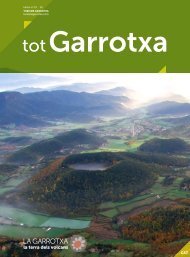Create successful ePaper yourself
Turn your PDF publications into a flip-book with our unique Google optimized e-Paper software.
Historyc route<br />
Castles and monasteries were at the centre of life in<br />
the Middle Ages. Although some of their splendour<br />
has waned, today La Gar-rotxa still maintains vestiges<br />
of that past in towns and villages such as Sant Joan<br />
les Fonts, Santa Pau and Besalú.<br />
We begin this medieval route in Sant Joan les Fonts<br />
and one of the first places we recommend you visit is<br />
the church of the old Benedictine monastery. To<br />
reserve a visit, please call: 972 29 05 07. Declared a<br />
National Monument, this monastery boasts three naves<br />
and porch covered by a late atrium. Also of note are the<br />
Romanesque baptismal font decorated with bas relief<br />
and a carved Christ figure, the original of which is kept<br />
in the Diocesan Museum in Girona.<br />
Dating from the same era is the medieval bridge that<br />
joins the old part of Sant Joan and the parish church to<br />
the Castanyer quarter. Built from volcanic rock, the<br />
bridge over the river Fluvià consists of a single large arch<br />
with two smaller lateral arches. Nearby we find the<br />
oldest Romanesque civil building in Catalonia, the<br />
castle of Juvinyà, a fortified manor house that was<br />
declared a Monument of National Interest in 1972. In<br />
recent years the building has been completely restored<br />
and now that has been converted into the Sant Joan les<br />
Fonts Territorial Interpretation Centre.<br />
he whole of the village of Santa Pau merits special<br />
attention. The historical centre is presided over by El<br />
Castell de la Baronia (the Baron’s castle), which is<br />
mentioned in documents from the 13th century<br />
onwards. Square in shape, this building today consists<br />
of a central courtyard and adjoining quarters that is<br />
the result of additions made between the 13th and<br />
15th centuries. To the south we find the triangular<br />
shaped Plaça Major, once known as the Firal dels<br />
Bous (the ‘oxen fairground’) since it was used as a<br />
marketplace and fairground. This medieval square,<br />
which has remained practically unchanged since the<br />
first decades of the 14th century, is one of the best<br />
conserved such squares in Catalonia.<br />
Besalú, the third stop on this medieval route, is one<br />
of the best preserved medieval towns in Catalonia<br />
and boasts religious and civil buildings (for example,<br />
the monastery of Sant Pere) of great interest. Founded<br />
in 977 and consecrated in 1003, the façade of<br />
Sant Pere is renowned for a highly original window<br />
adorned with the figures of two lions, symbols of the<br />
power and the protection provided by the church,<br />
which stand, respectively, on a monkey and a naked<br />
man, representations of evil and paganism.<br />
Medieval<br />
route





